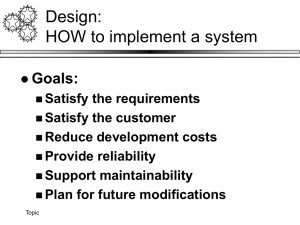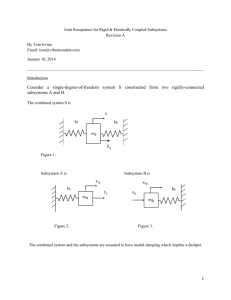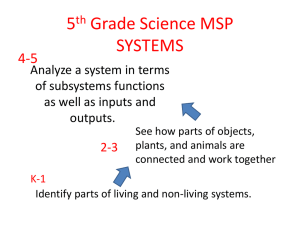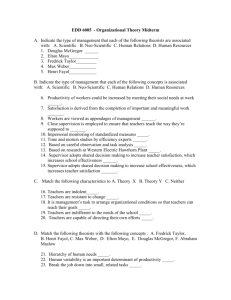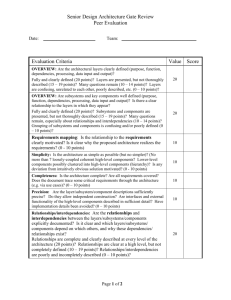Introduction to Software Design
advertisement
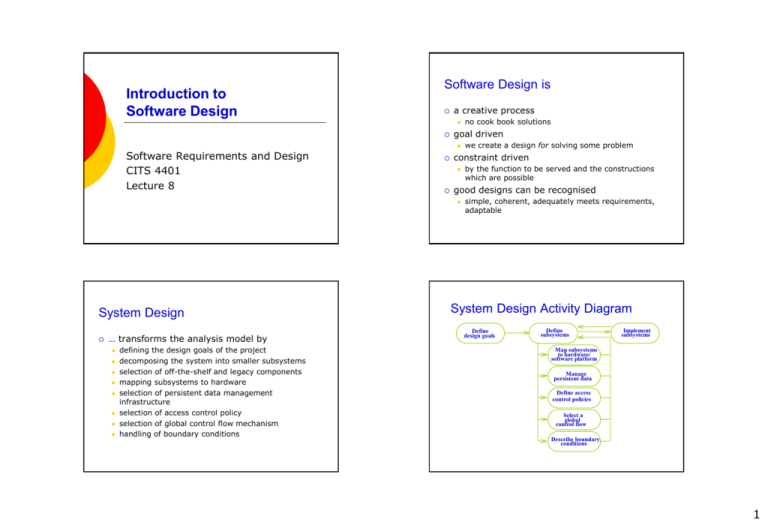
Introduction to Software Design Software Design is a creative process goal driven constraint driven Software Requirements and Design CITS 4401 Lecture 8 … transforms the analysis model by defining the design goals of the project decomposing the system into smaller subsystems selection of off-the-shelf and legacy components mapping subsystems to hardware selection of persistent data management infrastructure selection of access control policy selection of global control flow mechanism handling of boundary conditions we create a design for solving some problem by the function to be served and the constructions which are possible good designs can be recognised System Design no cook book solutions simple, coherent, adequately meets requirements, adaptable System Design Activity Diagram Define design goals Define subsystems Implement subsystems Map subsystems to hardware/ software platform Manage persistent data Define access control policies Select a global control flow Describe boundary conditions 1 Class diagrams in System Design Identifying Subsystems A first step in system design is to break down the solution domain into simpler parts. A SUBSYSTEM is a collection of classes, associations, operations, events and constraints that are inter-related Identifying subsystems usually involves backtracking, evaluation and revision of various solutions It is important to get the decomposition right Heuristics to Identify Subsystems Consider the objects and classes in your requirements analysis models. Try grouping objects into subsystems by assigning objects in one use case into the same subsystem create a dedicated subsystem for objects used for moving data among subsystems minimizing the number of associations crossing subsystem boundaries ensure all objects in the same subsystem are functionally related subsystems implemented by different teams bad decomposition can lead to unworkable designs Some further criteria Primary Question: what kind of service is provided by the subsystems? Secondary Question: Can the subsystems be hierarchically ordered (layers)? Criteria for selecting subsystems: most of the interaction should be within a subsystem and not across subsystem boundaries (we’ll return to this idea) 2 Coupling Modular design A design is modular when each activity of the system is performed by exactly one component inputs and outputs of each component are well-defined, in that every input and output is necessary for the function of that component the idea is to minimise the impact of later changes by abstracting from implementation details Coupling is the strength of dependencies BETWEEN two subsystems In general, the fewer dependencies between subsystems the better Why are fewer dependencies better ? 9 HIGH COUPLING Uncoupled no dependencies (bad) Content coupling Loosely coupled some dependencies Highly coupled many dependencies Common coupling Control coupling Stamp coupling LOOSE (good) Data coupling Uncoupled LOW 3 HIGH COHERENCE (good) Functional Coherence / Cohesion Coherence (or cohesion) is the strength of dependencies WITHIN a subsystem In general, the stronger the dependencies within a subsystem the better Why is (fairly) strong coherence best? Sequential Communicational Procedural Temporal Logical Coincidental FRIEND Objects - after Analysis FieldOfficer (E) Possible Subsystem Decompositions EmergencyReportForm (B) Possible Separation Criteria EmergencyReport (E) Incident (E) IncidentForm (B) LOW FieldOfficerStation (B) ReportEvent (C) Acknowledgement (B) (bad) Dispatcher (E) interface (boundary objects) from data (entity objects) Field Officer activities from Dispatcher ones use both the above splits one subsystem per use case (High) Cohesion and (Loose) Coupling are one measure of the “quality” of each subsystem decomposition DispatcherStation (B) 4 cohesion - good coupling - bad Interface vs Data FieldOfficer (E) FieldOfficerStation (B) ReportEvent (C) FieldOff vs Dispatch FieldOfficer (E) EmergencyReportForm (B) IncidentForm (B) EmergencyReportForm (B) EmergencyReport (E) Acknowledgement (B) Incident (E) FieldOfficerStation (B) ReportEvent (C) EmergencyReport (E) Acknowledgement (B) cohesion - OK coupling - good Dispatcher (E) Incident (E) IncidentForm (B) DispatcherStation (B) Combine Both Solutions FieldOfficer (E) cohesion - good coupling - good DispatcherStation (B) Design Summary (so far) FieldOfficerStation (B) ReportEvent (C) EmergencyReportForm (B) EmergencyReport (E) Acknowledgement (B) Dispatcher (E) Incident (E) IncidentForm (B) NB 2 moved associations Dispatcher (E) Design focuses on the solution domain. Requirements analysis focuses on the problem domain. In system design, objects identified during analysis are grouped into subsystems The degree of cohesion within and coupling between subsystems can be used to guide subsystem decomposition DispatcherStation (B) 5


